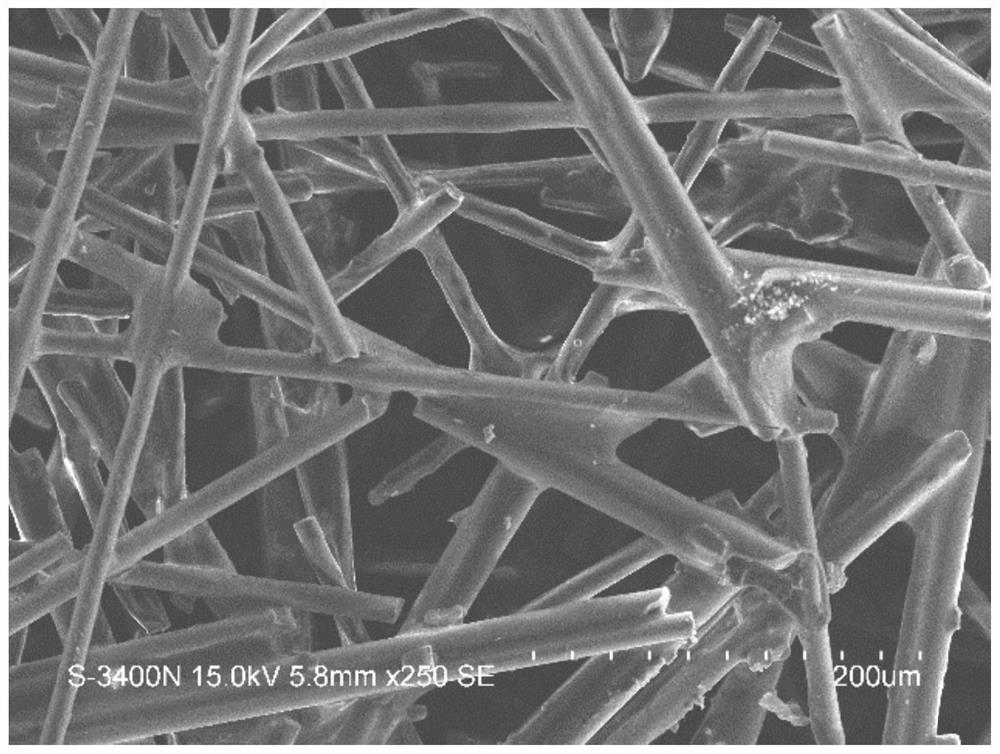A kind of fiber-reinforced rubber-elastomer composite material and preparation method thereof
A technology of rubber elastomers and composite materials, applied in the field of composite materials, can solve the problems of limited material compression resistance, high viscosity, weak interface bonding strength, etc., and achieve the effect of improving compression resistance.
- Summary
- Abstract
- Description
- Claims
- Application Information
AI Technical Summary
Problems solved by technology
Method used
Image
Examples
preparation example Construction
[0046] The preparation method of the thermosetting solder comprises the following steps: mixing a thermosetting resin, a curing agent and an accelerator, and mixing them uniformly with a stirrer to obtain the thermosetting solder. The viscosity of the thermosetting solder can be adjusted by means of constant temperature heating (less than 90° C.). The longer the constant temperature time is, the greater the viscosity will be (after the constant temperature time is over, the temperature will be cooled by an ice-water bath immediately).
[0047] The rubber matrix is a vulcanized thermosetting rubber, and a vulcanizing agent needs to be added during vulcanization. The mass ratio of the vulcanizing agent to the thermosetting rubber is 0.1-5%, preferably 1%, 3%, or 5%. In addition, the rubber matrix may be liquid or solid, with a viscosity of 0.1-100000 Pa.s, preferably 1-2000 Pa.s.
[0048] Described thermosetting rubber is conventional rubber, comprises solid rubber and liquid ...
Embodiment 1
[0062] Vinyl silicone rubber SR-1 (viscosity of 50rad / s at room temperature is 1370Pa.s), vulcanizing agent dicumyl peroxide (content is 1% of the quality of silicone rubber) and glass fiber GF-KH560 (surface ring Oxygen group) into the internal mixer, blending at room temperature for 1min, adding epoxy resin EP (EP consists of E-51 resin (brand YD128) and curing agent methyl hexahydrophthalic anhydride, accelerator 2,4,6 -Tris(dimethylaminomethyl)phenol composition, the mass ratio of E-51 resin, curing agent methyl hexahydrophthalic anhydride, accelerator 2,4,6-tris(dimethylaminomethyl)phenol is 100: 70:5.), after continuing to blend for 10 minutes, take out the sample. Firstly, it is cured at a temperature of 100°C for 30 minutes; then it is vulcanized at a temperature of 150°C for 30 minutes, and two-step compression molding is performed to obtain a fiber-reinforced rubber elastomer composite material. The mass ratio of SR-1, epoxy resin EP and GF-KH560 is 80 / 20 / 30. The v...
Embodiment 2
[0064] The mass ratio of SR-1, EP and GF-KH560 is 80 / 20 / 20, and others are the same as in Example 1. The maximum compressive strength of the obtained fiber-reinforced rubber-elastomer composite is 1.95MPa, and the corresponding compressive strain is 9.6%, specifically The results are shown in Table 1.
PUM
| Property | Measurement | Unit |
|---|---|---|
| glass transition temperature | aaaaa | aaaaa |
| surface resistance | aaaaa | aaaaa |
| electrical resistivity | aaaaa | aaaaa |
Abstract
Description
Claims
Application Information
 Login to View More
Login to View More - R&D
- Intellectual Property
- Life Sciences
- Materials
- Tech Scout
- Unparalleled Data Quality
- Higher Quality Content
- 60% Fewer Hallucinations
Browse by: Latest US Patents, China's latest patents, Technical Efficacy Thesaurus, Application Domain, Technology Topic, Popular Technical Reports.
© 2025 PatSnap. All rights reserved.Legal|Privacy policy|Modern Slavery Act Transparency Statement|Sitemap|About US| Contact US: help@patsnap.com



